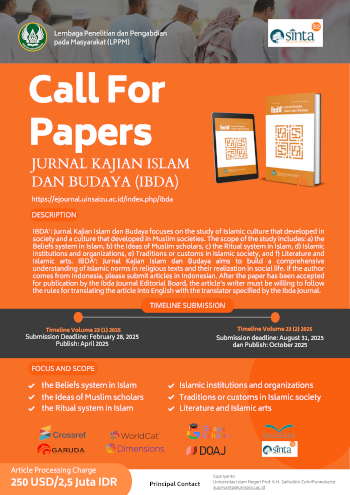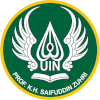Contesting identity through the market: Tourism and indigenous movement in Kasepuhan Ciptagelar, West Java
DOI:
https://doi.org/10.24090/ibda.v21i1.7781Keywords:
identity, cultural, Ciptagelar, indigenous, IslamAbstract
This study identifies the interplay between the engagement of Kasepuhan Ciptagelar, an indigenous community inhabiting the state forest in West Java, and tourism development in the area. Practising local spirituality rooted in an indigenous belief, tatali paranti karuhun, while administratively accepting Islam, the people have been struggling to deal with the nearby majority Sundanese who practices Islam and the establishment of the national park covering their living space. The study considers whether a minority group living in an area endowed with both natural and cultural tourism resources consciously chooses tourism as a selected ground to deal with policies which neglect them in terms of religious practices and land policy. Employing the ethnographic method, the study reveals that contesting identity in tourism also means the readiness to accommodate various outside elements. However, the strategy has led the Halimun Salak National Park authority to declare the area as a “special status area” for cultural tourism inside the state park since 2017. The study findings show that after engaging with tourism, various rituals and art performances rooted in the old Sundanese spirituality, which is not officially recognized by the state, can be freely performed for the sake of tourists. In this case, the community is not passive in dealing with external forces but has also enabled its own silent productivity, including its varying consequences.Downloads
References
Abdullah, M. (2012). Green vision dalam tradisi kearifan syariah Islam. Ibda’: Jurnal Kajian Islam dan Budaya, 10(1), 30–46. https://doi.org/10.24090/ibda.v10i1.47
Adams, V. (1996). Tigers of the snow and other virtual sherpas: An ethnography of Himalayan encounters. Princeton University Press.
Aly, H. (2015). Syariat dalam balutan ibadat dan adat. Ibda’: Jurnal Kajian Islam dan Budaya, 13(2), 97–111. https://doi.org/10.24090/ibda.v13i2.664
Benda-Beckmann, F. von, & Benda-Beckmann, K. von. (2011). Myths and stereotypes about adat law: A reassessment of Van Vollenhoven in the light of current struggles over adat law in Indonesia. Bijdragen Tot de Taal-, Land- En Volkenkunde / Journal of the Humanities and Social Sciences of Southeast Asia, 167(2/3), 167–195.
BPS. (2020). Provinsi Jawa Barat dalam angka. https://jabar.bps.go.id. https://jabar.bps.go.id/publication/2020/04/27/cfab9a400cf304f800182a5f/provinsi-jawa-barat-dalam-angka-2020.html
Buzinde, C. N., Manuel-Navarrete, D., & Swanson, T. (2020). Co-producing sustainable solutions in indigenous communities through scientific tourism. Journal of Sustainable Tourism, 28(9), 1255–1271. https://doi.org/10.1080/09669582.2020.1732993
Carr, A., Ruhanen, L., & Whitford, M. (2016). Indigenous peoples and tourism: the challenges and opportunities for sustainable tourism. Journal of Sustainable Tourism, 24(8–9), 1067–1079. https://doi.org/10.1080/09669582.2016.1206112
Chakim, S. (2022). A review of rituals and local wisdom of indigenous peoples in Indonesia. Ibda’: Jurnal Kajian Islam dan Budaya, 20(2), 181–199. https://doi.org/10.24090/ibda.v20i2.6439
Cohen, E. (2012). Globalization, global crises and tourism. Tourism Recreation Research, 37(2), 103–111. https://doi.org/10.1080/02508281.2012.11081695
Curtin, N., & Bird, S. (2022). “We are reconciliators”: When indigenous tourism begins with agency. Journal of Sustainable Tourism, 30(2–3), 461–481. https://doi.org/10.1080/09669582.2021.1903908
Dolezal, C., & Trupp, A. (2015). Tourism and development in South-East Asia. ASEAS: Austrian Journal of South-East Asian Studies, 8(2), 117–124. https://doi.org/10.14764/10.ASEAS-2015.2-1
Dong, T. B. (2020). Cultural tourism: An ethnographic study of home stay in Briddim Village, Nepal. The Gaze: Journal of Tourism and Hospitality, 11(1), 10–36. https://doi.org/10.3126/gaze.v11i1.26612
Dove, M. (1985). Peranan kebudayaan tradisional dalam pembangunan. Yayasan Obor Indonesia.
Fang, W.-T. (2020). Cultural Tourism. In W.-T. Fang (Ed.), Tourism in emerging economies (pp. 75–101). Springer Singapore. https://doi.org/10.1007/978-981-15-2463-9_4
Friedman, J. (2000). Cultural identity and global process. SAGE Publications Ltd.
Gamma, G., Sirait, M., N, R., Soenarto, F., & Nurzaman, B. (2005). History of land-use policies and designation of Mount Halimun-Salak National Park. Jurnal Manajemen Hutan Tropika, XI(1), 1–13.
Gedicks, A. (2001). Resource Rebel. South End Press.
Gray, A. (1997). Indigenous rights and development: Self-determination in an Amazonian community. Berghahn Books.
Heffner, R. W. (1999). Geger Tengger: Perubahan Sosial dan Perkelahian Politik. LKiS.
Higgins-Desbiolles, F., Blanchard, L.-A., & Urbain, Y. (2022). Peace through tourism: critical reflections on the intersections between peace, justice, sustainable development and tourism. Journal of Sustainable Tourism, 30(2–3), 335–351. https://doi.org/10.1080/09669582.2021.1952420
Holder, A., Walters, G., Ruhanen, L., & Mkono, M. (2022). Exploring tourist’s socio-cultural aversions, self-congruity bias, attitudes and willingness to participate in indigenous tourism. Journal of Vacation Marketing, 13567667221124344. https://doi.org/10.1177/13567667221124343
Honey, M. (1999). Ecotourism and sustainable development: Who owns paradise? Island Press.
Irianto, S. (2016). Masyarakat adat keindonesiaan. Kompas Daily Magazine.
James, S. (2010). The art of not being governed: An anarchist history of upland Southeast Asia. NUS Press.
Koentjaraningrat. (1993). Masalah kesukubangsaan dan integrasi nasional. Gramedia Pustaka Utama.
Kusdiwanggo, S. (2016). Konsep pola permukiman spasial di Kasepuhan Ciptagelar. Jurnal Permukiman, 11(1), 29–42.
Li, T. M. (2000). Articulating indigenous identity in indonesia: Resource politics and the tribal slot. Comparative Studies in Society and History, 42(1), 149–179. https://doi.org/10.1017/S0010417500002632
Longchar, W. (2014). Tourism Industry-an instrument of neo-liberal economic project: A ministerial challenge. The Asia Journal of Theology, 28(1), 59–69.
Moniaga, S. (2007). From Bumiputera to Masyarakat Adat: The revival of tradition in Indonesian politics. In D. Davidson, J. and Henley (Ed.), The deployment of adat from colonialism to indigenism (pp. 275–294). Routledge.
Mutaqin, Z. Z. (2014). Penghayat, orthodoxy and the legal politics of the state. Indonesia and the Malay World, 42(122), 1–23. https://doi.org/10.1080/13639811.2014.870771
Muttaqin, A., & Noor, N. M. (2022). Local Islam and Javanese culture penetration: Muslim Alif Rebo Wage (Aboge) negotiations in identity formation. Ibda’: Jurnal Kajian Islam dan Budaya, 20(1), 110–130.
Nordholt, H. S. (2007). Bali, Benteng Terbuka 1995-2005: Otonomi daerah, demokrasi electoral dan identitas defensive. Pustaka Larasan.
Peluso, N. L., & Vandergeest, P. (2001). Genealogies of the political forest and customary rights in Indonesia, Malaysia, and Thailand. The Journal of Asian Studies, 60(3), 761–812.
Picard, M. (1996). “Cultural tourism” in Bali: Cultural performances as tourist attraction." Indonesia, 49, pp: 37-74. Archipelago, the University of California.
Putri, S., Sukirno, & Sudaryatmi, S. (2017). Implikasi putas MK terhadap eksistensi hutan adat masyarakat yang tumpang tindih dengan hutan konservasi Taman Nasional Gunung Halimun Salak. Diponegoro Law Journal, 6(35), 1–22.
Rich, B. (1999). Mortgaging the earth: The World Bank, environmental impoverishment and the crisis of development. INFID.
Ricklefs, M. . (2017). Sejarah Indonesia modern. Gadjah Mada University Press.
Robertson, R. (1995). Glocalization: Time-space and homogeneity-heterogeneity. In Global modernities (pp. 25–45). Sage Publications, Ltd.
Royer, S. De, Visser, L. E., Galudra, G., Pradhan, U., & Van Noordwijk, M. (2015). Self-identification of indigenous people in post-independence Indonesia: A historical analysis in the context of REDD+. International Forestry Review, 17(3), 282–297. https://doi.org/10.1505/146554815815982648
Ruhanen, L., & Whitford, M. (2019). Cultural heritage and indigenous tourism. Journal of Heritage Tourism, 14(3), 179–191. https://doi.org/10.1080/1743873X.2019.1581788
Shiva, V. (1998). Staying alive: Women, ecology and survival in India. Zed Book Ltd.
Spradley, J. (1975). Anthropology: The cultural perspective . John Wiley and Sons Inc.
Subur. (2017). Religi Grebeg Sura di Banyumas. Ibda’: Jurnal Kajian Islam dan Budaya, 15(1), 59–75.
Topatimasang, R. (2004). Orang orang kalah. Insist Press.
Trupp, A. (2011). Exhibiting the “other” then and now: “Human zoos” in Southern China and Thailand. ASEAS-Austrian Journal of South-East Asian Studies, 4(1), 139–149.
Tsing, A. L. (2005). Friction: An ethnography of global connection. Princeton University Press.
Webb, R. . (1986). The sickle and the cross: Christians and communists in Bali, Flores, Sumba and Timor. Journal of Southeast Asian Studies, 17(1), 94–112.
Widiyanto, N. (2019). Indigenous religion revivalism and tourism development in Indonesia and Malaysia (A study on Kasepuhan Ciptagelar, West Java and Bundu Tuhan Dusun’s Community in Sabah). Universitas Gadjah Mada.
Widiyanto, N., & Agra, E. (2019). Tourism development and the new path of migration in Sabah, Malaysia. Borneo Research Journal, 13(1), 81–97. https://doi.org/10.22452/brj.vol13no1.5
Widyaningsih, R. (2017). Dimensi sosial dan religi kearifan lokal Banyumas. LPPM Unsoed.
Downloads
Published
How to Cite
Issue
Section
License
Copyright (c) 2023 Nur Widiyanto, Rindha Widyaningsih; Suhartapa

This work is licensed under a Creative Commons Attribution-ShareAlike 4.0 International License.
Authors who publish with this journal agree to the following terms:
- Authors retain copyright and grant the journal right of first publication with the work simultaneously licensed under a Creative Commons Attribution-ShareAlike License a that allows others to share the work with an acknowledgement of the work's authorship and initial publication in this journal.
- Authors are able to enter into separate, additional contractual arrangements for the non-exclusive distribution of the journal's published version of the work (e.g., post it to an institutional repository or publish it in a book), with an acknowledgment of its initial publication in this journal.
- Authors are permitted and encouraged to post their work online (e.g., in institutional repositories or on their website) before and during the submission process, as it can lead to productive exchanges, as well as earlier and greater citation of published work (See The Effect of Open Access).
















